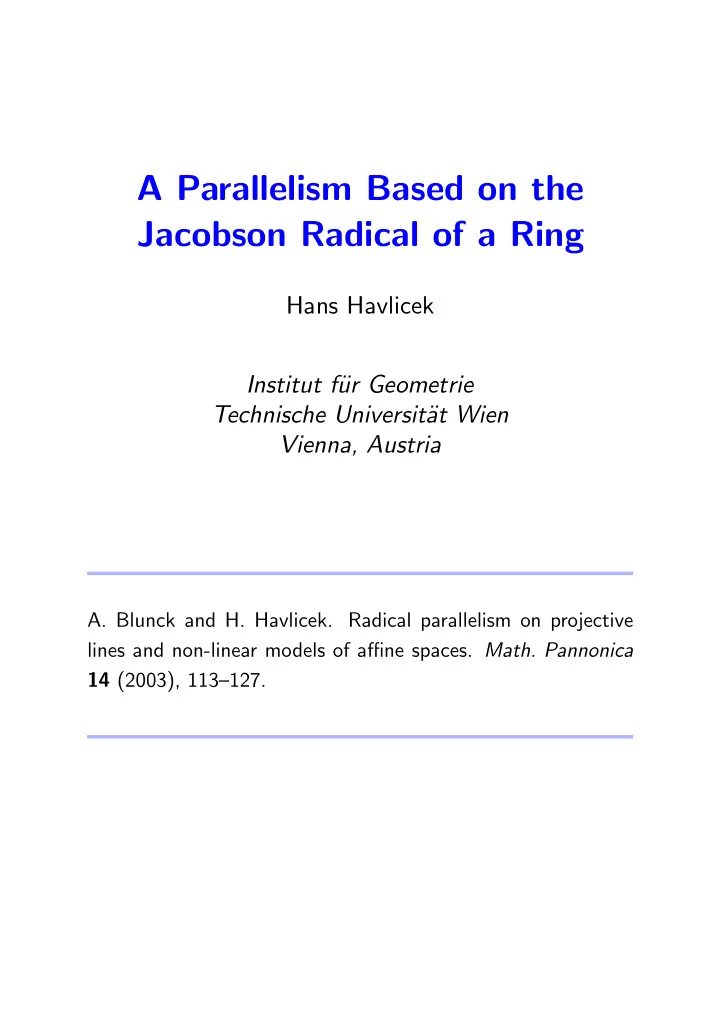

A Parallelism Based on the Jacobson Radical of a Ring Hans Havlicek Institut f¨ ur Geometrie Technische Universit¨ at Wien Vienna, Austria A. Blunck and H. Havlicek. Radical parallelism on projective lines and non-linear models of affine spaces. Math. Pannonica 14 (2003), 113–127.
The Jacobson Radical All our rings are associative, with unit element 1 � = 0 which is inherited by subrings and acts unitally on modules. Jacobson radical of a ring R : � rad R := all maximal left (or right) ideals of R The Jacobson radical rad R is a two sided ideal of R and R := R/ rad R has a zero radical. 1
The Meaning of the Jacobson Radical Let R ∗ be the group of invertible elements of R . In terms of R : 1 − ab ∈ R ∗ for all a ∈ R b ∈ rad R ⇔ 1 − ba ∈ R ∗ for all a ∈ R ⇔ In terms of matrices over R : � � 1 b b ∈ rad R ⇔ ∈ GL 2 ( R ) for all a ∈ R a 1 Observe that we cannot use determinants in order to invert a matrix over a non-commutative ring. 2
Examples Let R be a ring of matrices over a (skew-)field or a direct product of such rings: rad R = { 0 } E.g.: R 2 × 2 , R × R , R × C , . . . Let R be a local ring : rad R = R \ R ∗ E.g.: R = D = R + R ε , the real dual numbers . Let R be the ring of upper triangular 2 × 2 -matrices over a field F (ring of ternions ): It has an F -basis � 1 0 � � 0 0 � � 0 1 � j 1 := , j 2 := , ε := . 0 0 0 1 0 0 Maximal left ideals in R are F j 1 + F ε and F j 2 + F ε ; rad R = F ε. 3
The Projective Line over a Ring A pair ( a, b ) ∈ R 2 is called admissible if ( a, b ) is the first row of a matrix in GL 2 ( R ) . Projective line over R : { R ( a, b ) | ( a, b ) ∈ R 2 is admissible } P ( R ) := R (1 , 0) GL 2 ( R ) = Distant relation ( △ ) on P ( R ) : △ := ( R (1 , 0) , R (0 , 1)) GL 2 ( R ) It is symmetric and anti-reflexive. Letting p = R ( a, b ) and q = R ( c, d ) gives � � a b p △ q ⇔ ∈ GL 2 ( R ) . c d Non-distant points are also called parallel . 4
Three Classical Examples Complex numbers C : The relations ’ △ ’ and ’ � = ’ coincide. Parallel points are identical. Double numbers R × R : The parallelism is the union of two equivalence relations (meridians and parallel circles on the torus.) Real dual numbers D : The parallelism is an equi- valence relation (generators on the cylinder.) 5
The Radical Parallelism p, q ∈ P ( R ) said to be radically parallel ( p � q ) if x △ p ⇒ x △ q for all x ∈ P ( R ) . Properties : • The relation � is reflexive and transitive. • The relation � is finer than � △ , i.e. p � q implies p � △ q . (Let x = q in the definition.) • The relation � is invariant under the action of GL 2 ( R ) . We shall see that � is in fact an equivalence relation. 6
Algebraic Description Theorem. The point R (1 , 0) is radically parallel to q ∈ P ( R ) exactly if there is an element b in the Jacobson radical rad R such that q = R (1 , b ) . Recall that R := R/ rad R . Theorem. The mapping P ( R ) → P ( R ) : p = R ( a, b ) �→ R ( a, b ) =: p is well defined and surjective. It has the property p � q ⇔ p = q for all p, q ∈ P ( R ) . Therefore, � is an equivalence relation. 7
An Example The projective line over the ring R of upper triangular matrices over a field F can be identified with a special linear complex of lines (in a projective 3 -space over F ) without its axis, say a . a p △ q ⇔ p, q are skew lines p � q ⇔ a, p, q are in a pencil Remark: R/ rad R = R ∼ = F × F . 8
An Application Let A be an algebra over a field F . Then y �→ A ( y, 1) is a bijection of A onto the set of all points that are distant to A (1 , 0) . We shall identify these sets. Every projectivity of P ( A ) such that A (1 , 0) goes over to a distinct radically parallel point induces a bijective non-linear Cremona transformation on A . ⇒ Genereralizations of the parabola model of the real affine plane to higher dimensions. 9
Recommend
More recommend